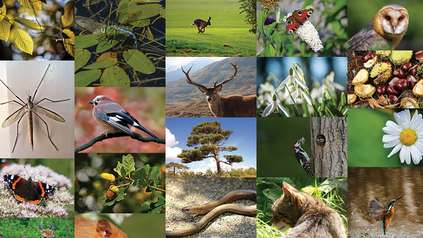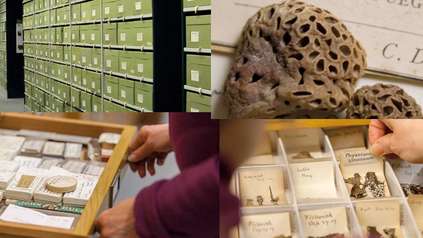Decoding first of 60,000 British species as Darwin Tree of Life branches out
A mission to map the genetic code of 60,000 British species is well underway as 150 species are in the process of having their DNA extracted and their entire genetic code read and assembled. Sanger Institute researchers and their collaborators within the Darwin Tree of Life project plan to sequence the genomes of 2,000 British species over the next two years, and then scale up to complete 60,000 species’ genomes with the next 10 years, Professor Mark Blaxter announced this week at a press briefing in New York.
The Darwin Tree of Life Project is just one of several initiatives across the globe working towards the ultimate goal of sequencing all complex life on Earth, in a venture known as the Earth BioGenome Project. The Sanger Institute will serve as a hub for sequencing and assembling the genomes of species from the British Isles. It will collaborate with partners* from a breadth of UK-wide institutions, museums and universities to identify and collect species, and then to annotate and share the genomes.
Darwin Tree of Life project partners are gearing up to collect, catalogue and deliver the 2,000 species specimens needed to complete the first phase of the project. To echo the goals of the Earth BioGenome Project’s first phase, Sanger and its partners will start by sequencing one species from each of families of animals, fungi, plants and other life found in Britain.
Researchers will be exploring some families of species in greater detail, such as British butterflies and moths, which act as indicator species for climate change. Butterflies and moths arrived in the UK following the last ice age and are, in some cases, drastically affected by current changes in the climate. Their genomic information will reveal how different butterfly species are coping with a varying environment.
Scientists are also exploring the genetic features of entire ecosystems, starting with British shorelines. Researchers are reading the genomes of British molluscs (snails and sea slugs), which will give insights into the impacts of climate change, pollution and invasive species in the oceans and on British shores.
The project partners chose to read the genetic code of species from the British Isles as they are extraordinarily well-studied already, and the genomic information will add to the wealth of knowledge around the species we share the environment with.
In the mission to sequence thousands of species’ genomes, Sanger Institute researchers are exploring new developments in long-read and long-range sequencing technologies, including Illumina, Pacific Biosciences, Oxford Nanopore Technology, and Bionano.
“We are really excited to get started on this great scientific adventure of sequencing life on Earth. We have committed to ensuring that the genomes we sequence, assemble and release are made openly available for those working in biology, conservation and biotechnology. We look forward to sharing the first fruits of the UK’s Darwin Tree of Life very soon.”
Professor Mark Blaxter Programme Lead for the Tree of Life programme at the Wellcome Sanger Institute
“This new programme of work will offer up incredible discoveries over the coming years. The science that we produce with our partners will deliver unprecedented and invaluable insights into the nature of all life. This knowledge will provide a foundation for the future of biology, it will present new opportunities for humankind and help us understand and preserve our inheritance of 3.5 billion years of life’s evolution on Earth.”
Professor Sir Mike Stratton Director of the Wellcome Sanger Institute
More information
*Partners and stakeholders of the Darwin Tree of Life project include the Wellcome Sanger Institute, national collections (the Natural History Museum, London, Royal Botanic Gardens, Kew, Royal Botanic Gardens, Edinburgh, leading universities and research organisations (University of Cambridge, University of Edinburgh, University of Exeter, University of Oxford, EMBL-EBI, Earlham Institute, Marine Biological Association, Plymouth, outreach and engagement organisations (Connecting Science) and funding agencies (BBSRC, Wellcome).
Funding:
The Tree of Life programme at the Wellcome Sanger Institute is supported by Wellcome.
Selected websites
The Wellcome Sanger Institute
The Wellcome Sanger Institute is a world leading genomics research centre. We undertake large-scale research that forms the foundations of knowledge in biology and medicine. We are open and collaborative; our data, results, tools and technologies are shared across the globe to advance science. Our ambition is vast – we take on projects that are not possible anywhere else. We use the power of genome sequencing to understand and harness the information in DNA. Funded by Wellcome, we have the freedom and support to push the boundaries of genomics. Our findings are used to improve health and to understand life on Earth. Find out more at www.sanger.ac.uk or follow us on Twitter, Facebook, LinkedIn and on our Blog.
About Wellcome
Wellcome exists to improve health by helping great ideas to thrive. We support researchers, we take on big health challenges, we campaign for better science, and we help everyone get involved with science and health research. We are a politically and financially independent foundation. https://wellcome.org/
About the Natural History Museum
The Natural History Museum exists to inspire a love of the natural world and unlock answers to the big issues facing humanity and the planet. It is a world-leading science research centre, and through its unique collection and unrivalled expertise it is tackling issues such as food security, eradicating diseases and managing resource scarcity. The Museum’s collection data is open by default and released onto the Museum’s Data Portal data.nhm.ac.uk which currently has over 4.3 million specimens on.
Since 2015, 17 billion records have been downloaded, over 220,000 download events and over 290 scientific papers that the Museum knows of cite the Museum’s scientists and their papers over a range of topics from Agriculture to Human health, biodiversity and Climate change. The Natural History Museum is the most visited natural history museum in Europe and the top science attraction in the UK; we welcome around five million visitors each year and our website receives over 850,000 unique visitors a month. People come from around the world to enjoy our galleries and events and engage both in-person and online with our science and educational activities through innovative programmes and citizen science projects.




